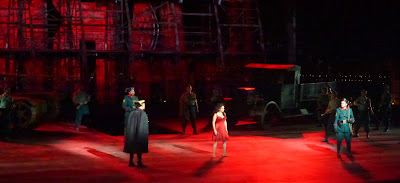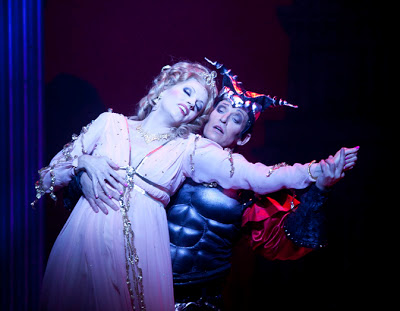 |
| Kate Bright (Prince Orlofsky) Jeremy Tatchell (Dr.Falke) |
By Johann
Strauss.
Director: Frank Ford A.M
Conductor:
Julie Sargeant
Presented by
Co-Opera
Albert Hall
– Canberra – 26th March 2013
Reviewed by
Bill Stephens.
Since 1990,
the Adelaide- based opera company, Co-opera, has been undertaking extensive
tours of fully-staged opera productions to regional and remote towns around
Australia, and occasionally overseas. Apart from the enjoyment they bring to
audiences who would otherwise have little chance to experience opera, these
productions provide excellent experience for rising young singers.
For their
current tour, director Frank Ford A.M. has adapted the popular Strauss operetta
“Die Fledermaus” for a cast of 11 singers and a small orchestra of six
instrumentalists, under the title of “The Revenge of the Bat”. Since its first performances in 1875, “Die
Fledermaus” has had many adaptations and titles, including “Pink Champagne”,
“Oh Rosalinda”, “Waltz Time” and “The
Bat” among them, but this is probably the only production that has been set in
Australia in the 1920’s. How appropriate therefore that it should be presented
in Canberra’s 1920’s Albert Hall during our Centenary Year.
Ford has
written new dialogue for his new adaptation, and provided a prologue, delivered by
Dr. Falke (Jeremy Tatchell) ), to explain Falke’s desire for revenge on his
friend Eisenstein, who, it appears, following a previous drunken fancy dress ball, had left Falke naked in the town square. Much of the following action is concerned
with mistaken identities, extra-marital flirtations and unlikely champagne-fueled mayhem before, during and after
another party thrown by the mysterious Prince Orlofsky (Kate Bright). Predictably though, by the end, all is resolved happily over yet another glass of sparkling
champagne.
 |
| Raymond Khong (Gabriel Von Eisenstein), Sara Lambert (Adele), Lynette Harris (Rosalinde von Eisenstein) |
The singing
through-out was confident and spirited, with Matthew Holzinger’s stylish musical arrangements
for the six piece orchestra providing a particularly attractive accompaniment.
For the most part
Kathryn Sproul’s touring set looked delightfully appropriate in the venue, and her costumes were witty and attractive, but, possibly
because of the lack of time to re-block the staging for the Albert Hall stage, the singers often looked cramped, appearing not
yet to have mastered the art of ‘dressing the stage”; too often "bread and buttering" together at the
back when they should have been occupying available empty space at the front.
Also, despite the fact that much of the dialogue, and some of the arias, most notably the famed “Laughing Song” sung by Adele (Sara Lambert) was delivered, disconcertingly,
in a exaggeratedly broad Australian strine, there was not much that was inherently
Australian about the production. The names and pedigree’s of the characters
remained unmistakably European (a
Hungarian countess, a Russian prince etc), and the situations steadfastly
resisted transplantation from their European origins.
 |
| Lynette Harris as Rosalinde von Eisenstein |
In his program notes Frank Ford mentions that
the production strives to capture “the vivacity and engagement of vaudeville
theatre”, which may account for the
semaphore acting style and over-emphasised delivery of most of the dialogue, and while most of the cast certainly worked diligently at being vivacious, the only one who really captured the vaudevillian spirit was Roderic Schultz as the
Police Inspector, Frank, whose clever drunken turn at the beginning of Act 3
was genuinely funny and provided the acting highlight of the night.
All the
characters in “Die Fledemaus” may be shallow and witless, but when played with
panache and style can appear exquisitely charming and funny. This cast has no
problems with the musical challenges of the piece, and once they discover how to make their characters believable, this production could well become the scintillating evening of operetta so obviously aimed for.
 |
| Sara Lambert (Adele), Roderic Schultz (Frank) , Lisa Cannissaro (Sally) |
















.jpg)










